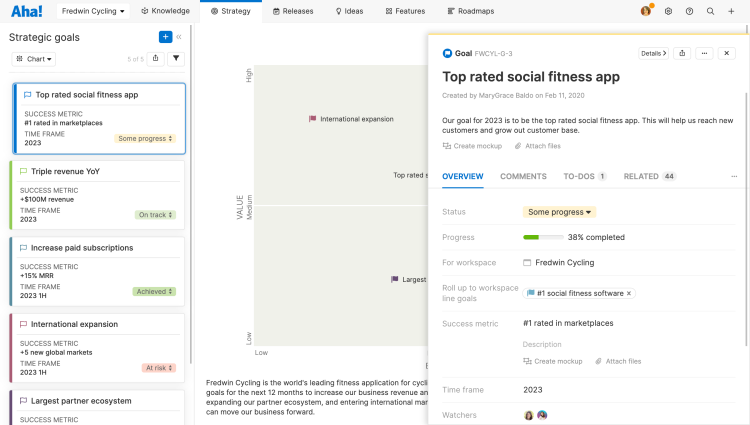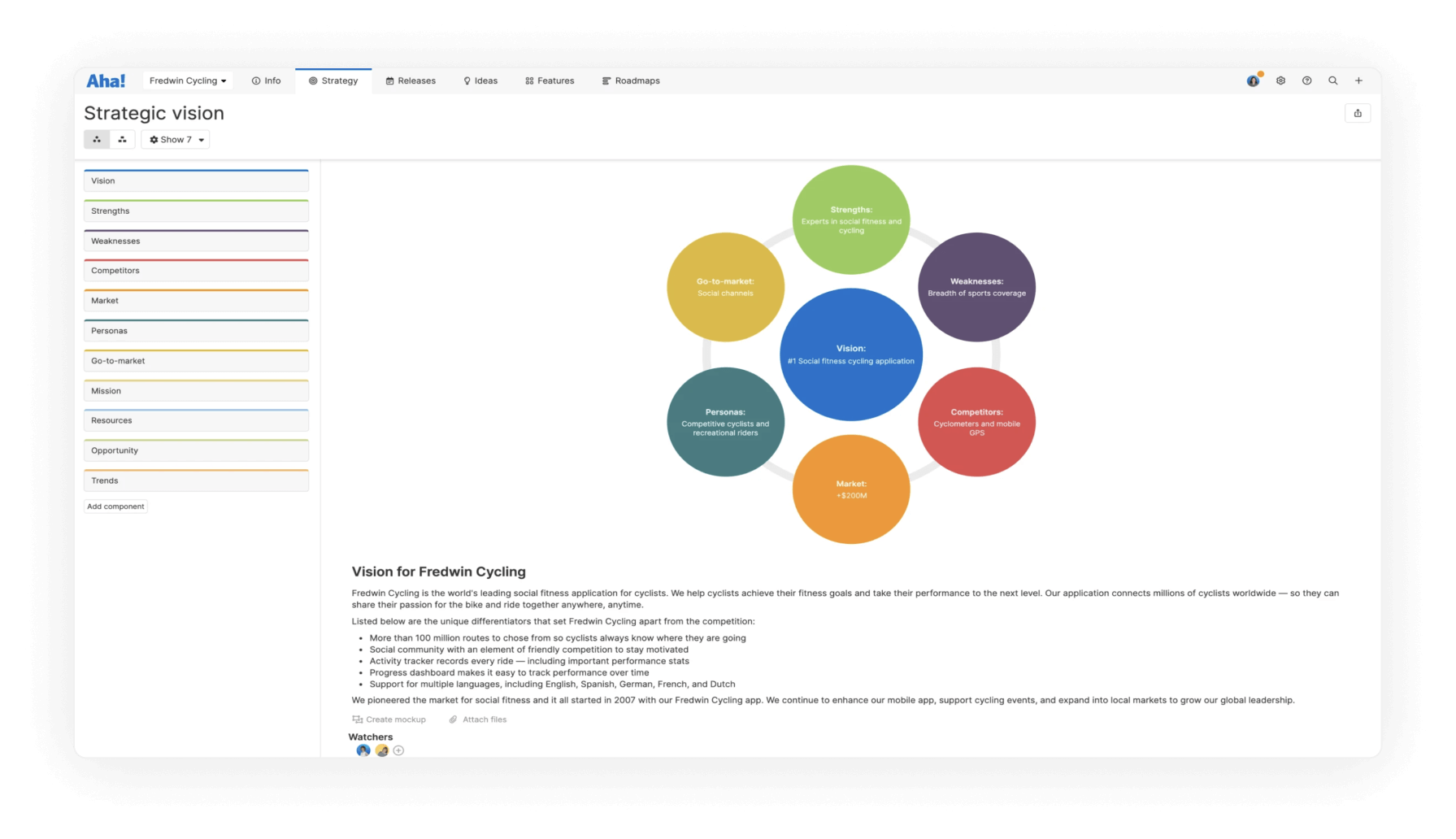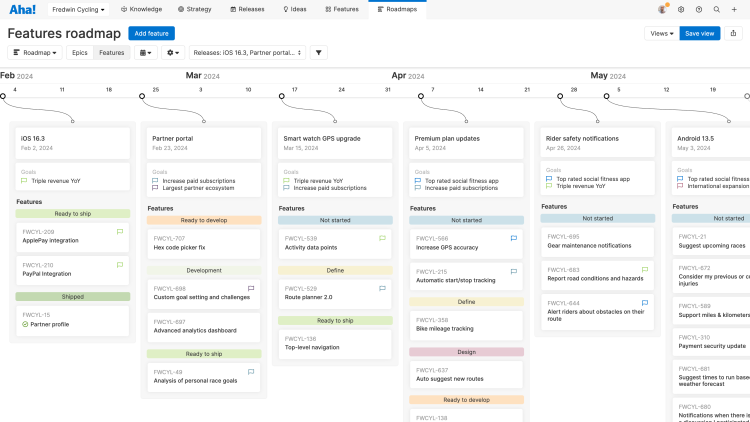How to create your product plan, step by step
Last updated: April 2024
What will you build? How will it support the business goals? And when will you deliver? Product planning is the process of answering these critical questions. The outcome is a product plan.
Product planning outlines how you will support business objectives — the goals and initiatives set in your company and product strategy.
After setting a high-level product plan, many teams create a detailed product roadmap to visualize the timeline for specific releases and features. A roadmap is a useful tool for showing how work aligns with strategy and communicating progress.
Build and track product plans in Aha! software. Sign up for a trial.
Explore topics in this guide:
Why is product planning important?
The goal of any product is to generate value for your customers and in turn, drive meaningful results for the business. So it is essential to have a unified plan that ties company objectives to the product-level work. For example, if your company has a goal to grow sales in Europe by 20 percent, you might bring that to the product level by expanding the languages that you support.
With the right strategic plan, you can identify business opportunities and make the right investment decisions. Your team is focused on the work that will best help your company achieve its goals and everyone is aligned around the "why" behind it. The outcome is a product or portfolio that better meets your customers' needs and maximizes value for the business.

Visualize strategic goals in Aha! Roadmaps.
When does product planning happen?
Strategy is typically set annually at the company level. This company strategy then informs the product strategy, which the VP of product or other senior product leaders set on an annual basis.
The actual timelines depend on the type of organization and level of detail required. For example, some companies look one, three, or even five years ahead. A one-year plan will likely be more detailed than a three-year plan because the delivery date is nearer.
Sound product planning requires adapting to shifts in the market and evolving customer needs too. This is why many companies do a quarterly business review to adjust and refine their product plans throughout the year.
No matter what planning horizon you use, the overall process is the same — start with the high-level business goals, initiatives, and areas of investment. You can add more detail about key features as you create a specific release plan or roadmap view.
What are the different approaches to building product plans?
Your organization's workflow and development methodologies will also affect how you approach product planning. And of course, whatever it is that you are building factors in as well. A software product is more easily changed midstream than a hardware product, for example. Your product plans will reflect that.
Some teams take a more waterfall approach — planning is done upfront, work is done serially, and change is uncommon. You typically see this in companies with longer service or manufacturing lead times. A market requirements document (MRD) and product requirements document (PRD) are examples of documents these teams might create to capture the market needs of customers and gather and define requirements upfront before the work begins.
This contrasts with agile teams who take a more adaptive and iterative approach to planning. These teams capture customer needs on an ongoing basis in the form of user stories, then they prioritize based on business objectives. This approach allows them to quickly assess product viability before investing significant time into the work. It also enables them to be more responsive to changing customer needs.
Related:
Start building your own product plans
While you can create successful products from the bottom up, it is more effective and efficient to determine where you would like to go first and then build your way there. Here is how to create great strategic plans at the company, product line, and individual product level:
Company level
Before you start to work on your strategic product plan, you must have a clear understanding of your company vision and goals. Without a clear vision and an agreed upon answer to "where are we headed?" it is nearly impossible to align your product plans to higher level goals and a corporate mission.

Define your company and product vision.
Ideally, your company's leaders have already defined and communicated a clear set of business goals. But if they have not (or if you need to work with them to refresh them), consider the following questions to build a vision that is unique to you and will delight both customers and employees:
Why are we in business?
What do we do better than anyone else?
What do our customers think of us?
What do our employees think of us?
What is the opportunity in our market over the next one, three, and five years?
Are there new market opportunities?
What are our revenue goals?
What are our expense goals?
Is technology changing the market or our business?
What are our competitors doing?
What are the top three most critical challenges our company will face in the next few years?
The responses to these questions will help you better understand the overall direction of the company and give you the clarity you need to set a winning strategy.
Divisions and product lines
If you have divisions, suites, or families of products, then the next layer of strategic planning needs to happen at the multi-product level. Even if you do not have a portfolio of products, you can define an umbrella set of goals and initiatives that span across related products. These should align to the higher level corporate goals and provide clear direction for individual product planning.

Create a portfolio roadmap in Aha! Roadmaps to show multi-level plans.
Portfolio planning provides an opportunity to align around strategic initiatives that will impact multiple child products. It also gives you the opportunity to:
Consider enhancements to the core platform infrastructure.
Highlight dependencies between products.
Identify the delivery capabilities needed to meet your goals.
This approach helps you to make investment decisions and coordinate a release schedule that serves all of your products.
Individual products
With a clear understanding of the higher level goals and initiatives, you can now create a strategic product plan that communicates where each product is headed. Research your competitors, revisit your customer personas, and update your specific product's business model to show how your product will continue to be a success.
You can then can build a product roadmap — a crucial part of the strategic planning process. With a roadmap, you can visualize how all of the features and detailed work connect to your strategy. The exercise in creating a roadmap forces you to prioritize the work and investments that matter most to achieving your product and company vision. And when new ideas are suggested, your strategy should guide your decisions about which ones to pursue.
It takes grit to reach internal agreement and put your strategy first, but it pays off in every possible way when you do. You are able to deliver more value to your customers, make more efficient use of your resources, and directly contribute to driving growth for your company. And your team will be happier and more productive too. The most effective teams know what they are working towards and understand exactly how their day-to-day efforts impact the product and the company as a whole.

Build a features roadmap for a detailed view of work.
If you are new to strategic planning, engage with executives and product leadership early in the process and invest the upfront effort to gain organizational alignment. This will empower you to build more successful and meaningful products and ensure the team is happy doing it.